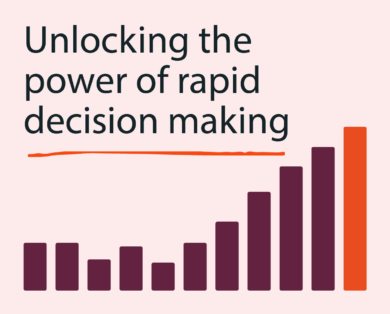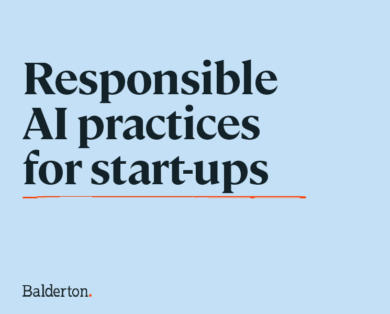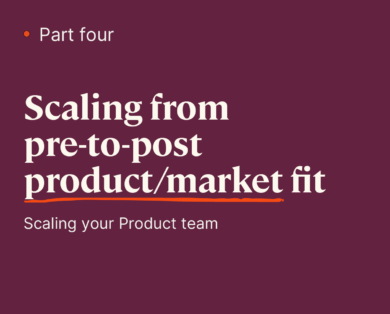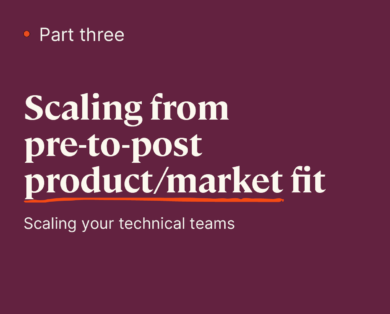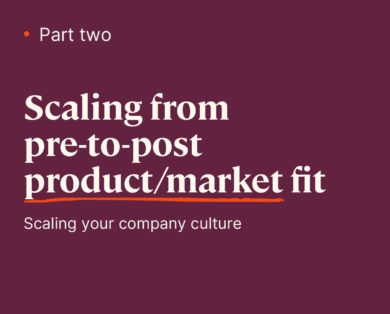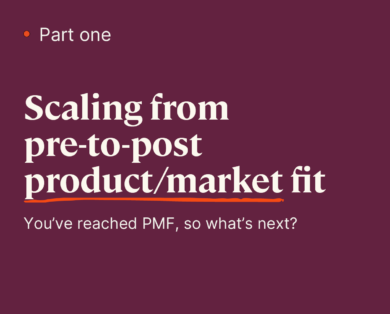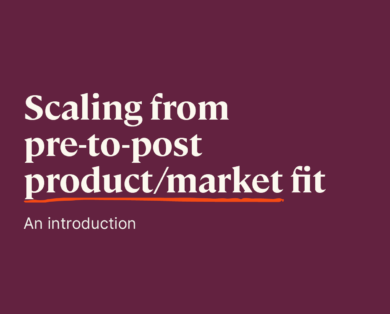- 09 April, 2025
BUILD
When, and how, to choose a PR agency for your Series A tech startup

Share
Raising a Series A round is a huge moment for any startup – it marks a significant validation of your team, your strategy and your future.
The Series A announcement is often a startup’s first major moment in the media. However, many startups at this stage do not have a full-time communications expert on the team, so the announcement can be a challenge. At Balderton, we deploy our own agencies to help build and pitch the news.
Are you ready for an agency?
It’s at this point that companies ask whether they should secure a communications agency, particularly if media coverage is an important part of the marketing mix to deliver on business objectives.To answer whether a PR / comms agency could help you, consider the following questions:- Can your important audience stakeholders can be ‘found’ through online and offline media channels, and do you have stories that could be compellingly told through those channels?
- Are you facing a very busy period, with six months to a year of fast and furious company activity, where there are new chapters to your story you want to tell in a coordinated ‘arc’?
- Are you operating in a fiercely competitive market, where others are getting more than their fair share of attention in the media, even though you have a better story to tell?
- Are you investing in ‘full stack’ marketing (SEO, content, paid media, offline activities etc), and need more dials to turn to widen the top of your marketing funnel?
- Are you experiencing a little too much ‘unwanted attention’ (or you think there is a risk could happen) and need regular counsel on how to respond to that attention?
- Are you embarking on disruptive and/or controversial activities that require influence through the media, so that your position is clearly understood by those you wish to influence?
There are many other good reasons to bring on board an agency, but if the answer to one or more of these questions is largely ‘yes,’ it’s time to think about devoting spend to an agency.That’s not to say that a really experienced in-house comms leader can’t handle these issues – but the right agency can add the reach, relationships, and counsel that can positively leverage and expand that team member’s impact, as well as challenge embedded thinking in a positive way.
8 steps to selecting an agency:
- Agree to goals
- Build a requirements doc
- Make a shortlist
- Cold call/write (prune 1)
- Online / phone interview (prune 2)
- Longer video interview (prune 3)
- In-person interviews
- Decision time
1. Goals
Establish and agree your goals internally for what you expect of the comms function Without setting goals, you’re not ready to talk to potential agency hires.For example, Series A startups frequently cite the following goals for earned media:
Build awareness of your product / service among a specific audience
This is an often-cited goal but can be dangerously vague. If building awareness is a goal, then you must be very specific about:Who? – who do you want to hear about you? Customers, brand partners, developers, business leaders, governmental leaders, venture firms, acquisition targets? Which geography? Which demographic?What? – what story do you want these audiences to hear?Where? – you may not know this already, but where do you want to reach those people? If you don’t know, this is something an agency will be able to help with.If you don’t know all these answers yet, that is OK. The agency you choose should help you here. However, it’s good to have a sketch of an idea of your ideal outlet(s) and journalist(s).Establish yourself, and/or your company, as leaders in an existing category, or creators of a new category
Disruptive tech solutions, services and products often find themselves in a position where they don’t fit ‘neatly’ into, say, a Gartner quadrant. This becomes a process of educating the market – and those who influence the market – for the need for this new category. Analyst relations, for example, may help in this regard. Query candidates specifically on their experience in analyst relations.Attract talent to come work for you
The best talent isn’t looking for a job – they already have a job. What are they reading? Whose opinion do they value? What stories can you tell that will encourage them to quit and come work for you.2. Requirements doc
Agencies typically aren’t fans of RFPs/RFIs. They can take a lot of time to respond to, and time responding is time that isn’t being billed to a paying client.But that’s not your problem.Even a brief document can be a good forcing function for you, as a client. It can also be a forcing function for an agency.The document doesn’t have to be long – two – three pages are sufficient. The document becomes a ‘test’ for whether an agency is paying attention. If you reach out to agencies with clear goals, only to have the agency wholly ignore them and decide your goals are something else altogether, it’s a red flag. While it’s just fine for an agency to challenge assumptions, it’s not fine to ignore you altogether.We have a template for an RFP/RFI we share with portfolio teams. However, you can easily google templates online and adjust them to your needs. Our template broadly covers:
- Overview: what type of agency partner you’re looking for, start and duration of the engagement
- The top goals you have agreed as a team for your first year of engagement with your communications firm. Think: if you can achieve these goals for me within the first year of engagement, I’ll be a happy client.
- Requirements you’re looking for in an agency:
Required (e.g. strong experience in tech B2B; specific geographical knowledge; relationships in Silicon Valley; analyst relations)
Nice to haves (e.g. a multi-lingual team based in Paris; SEO experts; social influencer expertise;) - Desired working relationship (e.g. tools you’d prefer them to use; whether you would like regular in-person meetings; what kind of tracking / measurements you expect them to adhere to)
- Your company and critical team member(s) overview: Include your company background, history, past experience with PR, bios of key people, where you are as a company
- What you want to receive from the agency in a response: This might include: biographies of team members; case studies; budget requirements; existing and prior client lists (particularly those in your sector); and broadly how they would approach meeting the goals you have stated.
3. Make a shortlist
Now you’re ready to share the RFP with a shortlist of no more than six agencies. Where to start?Ask people you trust and look around your ecosystem. Who is always getting positive media mentions? Who is handling tricky media well? Find out who their agency is. Start with companies who are in your field, but not competitive. (If you snoop agencies used by your competition, you will likely run into conflicts of interest.)How do you find the agency name? See if you can find the company’s Head of Marketing or Comms Manager on LinkedIn – with any luck they’ll just tell you. Or, if they’ve done press releases, they may list a “for information, contact:” in Cision/PRNewswire, for example.At Balderton, we track the agencies that our portfolio companies, as well as those we know are of repute in the industry. And while we never specifically recommend an agency, we do offer guidance of those that might belong in a shortlist.
What size agency?
There are pros to choosing a large, multinational agency (broad skill set; geographical reach; large and experienced teams; high profile relationships) or a boutique agency (you’re a more important client to them; super experienced senior people working for you directly; niche industry experience; small, close-knit teams; more personalized attention).The budget also dictates the size of agency you choose.A monthly retainer of $15K will get the attention of a boutique agency, but not of a large multinational agency. If your budget is on the lower end (<$10K/month) you’ll only be able to work with a boutique agency.4. Cold call / email
Ask if they’d like to have a brief introductory call with you.Some firms may not respond. Strike one. Actually, strike OUT. You can learn from their interaction with you – if it’s fast, crisp, well written, and efficient, that’s a good sign. If the firm doesn’t have its act together enough to follow up on an incoming enquiry, it tells me that they don’t handle the important details well. Move on.
5. Telephone / video interview (brief)
In this call, you’ll want to answer three questions:
- Check to see if there’s a conflict of interest;
- Check that they could potentially take on your workload. Some of the smaller firms may be too busy to give you the love you deserve, so it’s good to get that questions out of the way.
- See if you like their general reaction.
6. Telephone / video interview (longer)
This is a killer step: if they have read your RFP, researched you, and they ask intelligent questions, that’s good.If they don’t speak to your goals, and haven’t done any research on you, don’t bother seeing them face-to-face – it’s a waste of your time.Some questions you need to get answered:
- Who specifically will be working on your account Don’t choose a firm without absolutely confirming, and meeting, the people who will actually be working on your account. Don’t be taken in by the ‘bait and switch’ – where you meet the fabulous comms guru at the top who can do all the name-dropping, with whom you fall in love, and then you get someone wholly else working on your account. You should know in advance who is going to be calling journalists on your behalf.
- Has the team worked on accounts similar to yours in the past – this is where case studies should be shared
- How many other accounts will the manager working on your account be handling, and which are they
- How many clients does the firm currently manage actively
- What overall percentage of the firm’s work would your account represent
7. Face-to-face
Hopefully, you’re down to three firms by this time. Only now do you need to spend time face to face. Are they willing to come to your space? They should be. Do they bring 15 people? That’s an overshare. You only need to meet the people who will work directly on your account, who you need to get to know well. Make the interview face to face as much of a ‘working’ session as possible – so you can get a feel for what it might be like to have them on your team.
The pitch
Tell them to keep the face to face time focused on what they’ll do for you, rather than lots of case studies of their work. At this point, you should be comfortable they are qualified to do the work and you don’t need to have their case studies repeated.Does the pitch they bring with them speak to what you want, as outlined in the RFP? At this point, you should expect a preliminary idea of how they’d approach reaching the goals you have generously outlined for them; if they don’t, and they haven’t done their homework, it tells me they don’t care and should be discounted. While you cannot expect an agency to have fully understood you and your market, you should at least see one (or even two) ideas you’re excited about in their pitch.The working relationship
An agency is only as good as the way they are managed, and how much you help them to be successful. Lines of communication are, therefore, absolutely critical.Find out how often they would meet face to face, and how often for virtual checks ins. I think weekly 30-minute status calls are great, and at least a one month face-to-face. At that point, I’m happy to go to their office. I want them to spend their hourly time working for me, not commuting to see me.Find out how they track projects. What tools do they use? Do they match your style of project management? Do they seem like they’re in the Agile camp, where you can always see the status of what’s going on and is this important to you?Finally, do you click? Will you enjoy working with this team? Does your gut tell you can rely on them in a crisis? Chemistry matters!The budget
At this point, the agency should also look to help you define a reasonable budget, with what would be included and excluded. Agencies will likely want a baseline ‘retainer,’ just to be on call to you. You can negotiate a three- or six-month initial engagement, with an opt-out. Agencies don’t like “project” basis engagements (“just do this press release and announcement for me“), though they may accept that work to get their foot in the door. However, you’re never going to get the best results from this manner of engagement. If this is what you feel you really need now, it’s best to find a freelancer who can take on the project.8. Decision time
The agency you choose is a trusted partner. You’ll be sharing a great deal with them, so you have to know you can rely on them completely to give you sage advice and retain confidentiality. Ask references about this aspect of their relationship with the agency.


